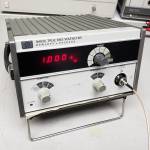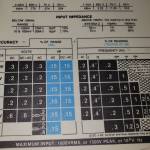[HP 346A/B/C noise Source]
| First Catalog | <year> |
|---|---|
| Last Catalog | <year> |
| <attribute1> | <value1> |
| <attribute2> | <value2> |
| <attribute3> | <value3> |
The HP346 A/B/C noise sources are general purpose noise sources to be used with a noise figure meter like the HP8970A/B. The HP346A is a low ENR (typical 4.5-6.5 dB) source from 10 MHz to 18 GHz, the “B” is a high ENR (14-16 dB) source from 10 MHz to 18 GHz, the “C” is like the “B” but goes to 26.5 GHz with APC 3.5 connector. Different connector options exist. The supply voltage of 28 V, normally switched, is supplied by the meter (via a BNC cable). Internally, the noise source consists of a noise generator (usually an OEM product based on a noise diode) running on 28 V, followed by one or more attenuators. The meter will normally use the Y-factor method, the ratio between the output power of the DUT at Cold (noise source off) and Hot (Source on) condition. The sources are provided with a label with calibration values at standard frequencies. Besides the ENR calibration it is very useful to have the reflection coefficient (RC or gamma) values available to calculate the uncertainty of the noise figure measurement as function of the S11 of the DUT. The advantage of a low ENR source is that, due to more attenuation after the internal noise generator, the difference between the gamma-on and gamma-off is very small, so the DUT will show less gain variation (so better Nf accuracy).
If the noise source is treated with care the calibration holds a remarkably long period of time (maybe even decades). A simple but useful functionality check can be performed with a sensitive RF power meter. Refer to Operating and Service manual (00346-90148). It is very well possible to calibrate one source against the other with a well calibrated and adjusted noise figure meter (e.g. HP8970A/B).


